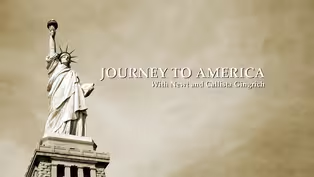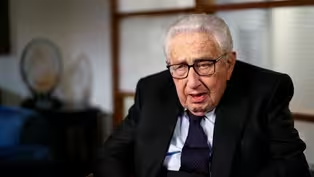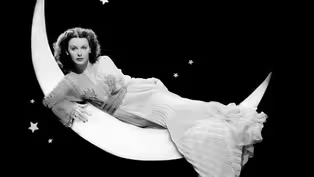
Hedy Lamarr
Clip: Season 1 | 4m 59sVideo has Closed Captions
Hedy Lamarr's journey to America.
After an overview of her career, we follow Hedy Lamarr’s life starting in Austria, to her fleeing and increasing hostile environment in pre-war Austria, to Hollywood and her life as both a movie star and as an inventor of a technology used today in all WiFi and Bluetooth products.
Problems playing video? | Closed Captioning Feedback
Problems playing video? | Closed Captioning Feedback

Hedy Lamarr
Clip: Season 1 | 4m 59sVideo has Closed Captions
After an overview of her career, we follow Hedy Lamarr’s life starting in Austria, to her fleeing and increasing hostile environment in pre-war Austria, to Hollywood and her life as both a movie star and as an inventor of a technology used today in all WiFi and Bluetooth products.
Problems playing video? | Closed Captioning Feedback
How to Watch Journey to America: with Newt and Callista Gingrich
Journey to America: with Newt and Callista Gingrich is available to stream on pbs.org and the free PBS App, available on iPhone, Apple TV, Android TV, Android smartphones, Amazon Fire TV, Amazon Fire Tablet, Roku, Samsung Smart TV, and Vizio.
Buy Now
Providing Support for PBS.org
Learn Moreabout PBS online sponsorship(dramatic music) Political unrest in Europe in the 1930s brought not only future political figures, but also artists to the United States.
America offered the possibility of a new future.
(upbeat jazz music) She was one of the greatest stars during Hollywood’s golden age.
But Hedy Lamarr was much more than Hollywood royalty who worked with legends, including Clark Gable, Lana Turner, Judy Garland and James Stewart.
(soft music) She was also an ingenious inventor who co-created a secret communications system during World War II, pioneering a technique that led to breakthroughs in modern Wi-Fi technology.
(gentle music) Hedy Lamarr, born Hedwig Eva Maria Kiesler in 1914, in Vienna, Austria, the only child of Emil and Gertrud Kiesler.
At the age of five, Hedy first showed an interest in technology when she dismantled and reassembled a music box.
She sort of undid it, put it back together.
And, you know, much later in her life, she would be inventing things that actually put things together for the better of mankind.
(light orchestral music) In her teens, Hedy began to model, and played small roles in movies.
Her beauty was her calling card.
People were really astounded even at a younger age there, as a teenager, she had a unique look.
(dramatic music) At 18, Hedy married a relentless suitor, a 33-year-old arms manufacturer named Friedrich Mandl.
He was one the wealthiest men in Austria.
He also controlled Hedy’s career, and eventually her freedom of movement.
And Lamarr, of Jewish decent, disapproved of her husband’s increasing ties with Germany and the rising Nazi Party.
The marriage didn't work out for her.
This was the first of many, many marriages.
But she wanted to get out.
She wanted to get out of there altogether and move on with her life.
(dramatic orchestral music) It was a very risky move at that time for Hedy to leave this man, you know, who was traveling in those very, very high-profile circles there too, and to get out of there, and she was very concerned about her mother as well.
She was a very smart person, even at a young age, she could see the way things were going, and her whole goal was to get out of there and move on, and she did.
In London, Hedy met Louis B. Mayer, the head of MGM Studios.
Mayer offered her a contract for $125 a week.
Hedy turned him down, but soon regretted it.
Louis B. Mayer, the celebrated head of MGM, knew that a big ticket for filmgoers were these European beauties.
And he was in Europe looking for more, more along the lines of Louise Reiner, who won back-to-back Academy Awards and many of these emigres, and Marlene Dietrich and Garbo, and all of these people that came to MGM and Hollywood too.
And he was looking for more.
(romantic orchestral music) Hedy booked a ticket to the United States on the same cruise ship as Mayer, The Normandie.
And so, she would make sure she was seen walking across that ship, and seeing all these young men and other people on that ship turning around, who's that?
Who is that?
And knowing that Louis B. Mayer would be noticing this too, she made sure she was in the right places for that.
Very, very clever, and it worked.
He came back, offered her $500 a week to come in there and sign with MGM.
In 1938 Louis B. Mayer promoted Hedy as the ‘World’s Most Beautiful Woman’.
Her first American film, Algiers, with Charles Boyer, made her a star.
Do you know Paris?
Do I know Paris?
La rive Saint-Martin.
Champs-Élysées.
La Gare du Nord.
The Opéra.
Boulevard des Capucines.
Abbesses.
La Chapelle.
Rue Montmartre.
Boulevard de Rochechouart.
Rue Fontaine.
La Place Blanche.
(laughter) (dramatic music) She certainly knew the camera, I think instantly knew the camera, and what the camera was getting.
The camera does not lie.
And the camera knew that Lamarr was a star.
Video has Closed Captions
Preview: S1 | 30s | Inspiring immigrant stories from those who have come to the U.S. from other nations and excelled. (30s)
Video has Closed Captions
Clip: S1 | 4m 59s | Henry Kissinger's journey to America. (4m 59s)
Video has Closed Captions
Clip: S1 | 4m 59s | Hedy Lamarr's journey to America. (4m 59s)
Providing Support for PBS.org
Learn Moreabout PBS online sponsorshipSupport for PBS provided by:


















